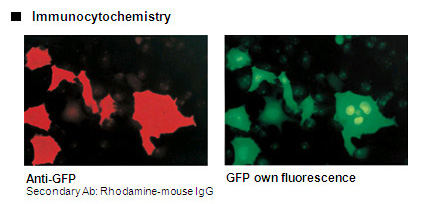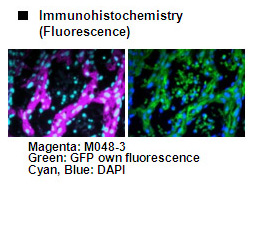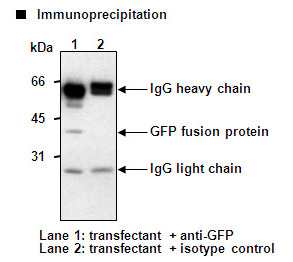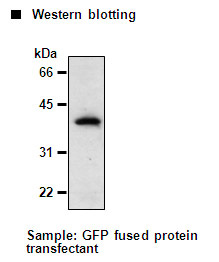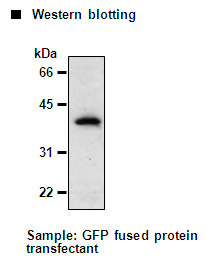Anti-GFP (Green Fluorescent Protein) mAb
| Code | Size | Price |
|---|
| MBL-M048-3 | 100 ug | £264.00 |
Quantity:
Prices exclude any Taxes / VAT
Overview
Host Type: Mouse
Antibody Isotype: IgG2b
Antibody Clonality: Monoclonal
Antibody Clone: 1E4
Regulatory Status: RUO
Applications:
- Immunocytochemistry (ICC)
- Immunohistochemistry (IHC)
- Immunoprecipitation (IP)
- Western Blot (WB)
Shipping:
4°C
Storage:
-20°C
Images
Documents
Further Information
Applications:
WB - 1 ug/mL (chemiluminescence detection system) IP - 5 ug/sample ICC - 2 ug/mL IHC - 10 ug/mL
Background:
Green Fluorescent Protein (GFP) tagging provide an excellent means for monitoring gene expression and protein localization in living cells, so that it is widely accepted by molecular and cell biological research. Monoclonal anti-GFP antibody can detect GFP and its variants on Western blotting, Immunoprecipitation and Immunocytochemistry.
Concentration:
1 mg/mL
Formulation:
100 ug IgG in 100 ul volume of PBS containing 50% glycerol, pH 7.2. No preservative is contained.
Immunogen Translated:
Full-length recombinant GFP protein (246 a.a.)
Reactivity:
This antibody reacts with GFP on Western blotting, Immunoprecipitation and Immunocytochemistry. It reacts with EBFP, SEBFP, ECFP, SECFP, EGFP, SEGFP cpSEGFP, EYFP, Venus, cpVenus, R-pericam, and Sapphire.
Shelf Life:
1 year
Source:
This antibody was purified from hybridoma (clone 1E4) supernatant using protein A agarose. This hybridoma was established by fusion of mouse myeloma cell P3U1 with Balb/c mouse splenocyte immunized with recombinant full length GFP protein (246 aa).
Target:
GFP
References
1)
Asada, N. and Sanada, K., J. Neurosci. 30, 8852-8865 (2010)
2)
Banerjee, S., et al., Neuron 64, 871-884 (2009)
3)
Komuro, A., et al., J. Natl. Cancer Inst. 101, 592-604 (2009)
4)
Nakanishi, M., et al., J. Biol. Chem. 282, 22993-23004 (2007)
5)
Takeda, K., et al., J. Biol. Chem. 282, 7522-7531 (2007)
6)
Reversi, A., et al., Am. J. Physiol. Regulatory Integrative Comp. Physiol. 291, R861-R869 (2006)
7)
Hanamoto, T., et al., J. Biol. Chem. 280, 16665-16675 (2005)
8)
Reversi, A., et al., J. Biol. Chem. 280, 16311-16318 (2005)
9)
Konstantopoulos-Kontrogianni, A., et al., Am. J. Physiol. Cell Physiol. 287, C209-C217 (2004)
10)
Broday, L., et al., J. Cell Biol. 165, 857-867 (2004)
11)
Hisatsune, C., et al., J. Biol. Chem. 279, 18887-18894 (2004)
12)
Pottekat, A., et al., J. Biol. Chem. 279, 15743-15751 (2004)
13)
Lozupone, F., et al., J. Biol. Chem. 279, 9199-9207 (2004)
14)
Iwai, S., et al., J. Biol. Chem. 279, 4696-4704 (2004)
15)
de Graaf, K., et al., J. Biol. Chem, 279, 4612-4624 (2004)
16)
Kimura, F., et al., J. Biol. Chem. 278, 25046-25054 (2003)
17)
Song, Z., et al., J. Biol. Chem. 278, 23130-23140 (2003)
18)
Nakamichi, I., et al., Mol. Biol. Cell 13, 3441-3451 (2002)
19)
Ozoe, F., et al., Mol. Cell Biol.22, 7105-7119 (2002)
20)
Ko, H. S., et al., J. Biol. Chem. 277, 35386-35392 (2002)
21)
Masuda, M., et al., J. Biol. Chem. 277, 31014-31019 (2002)
Clone 1E4 is used in these references.


